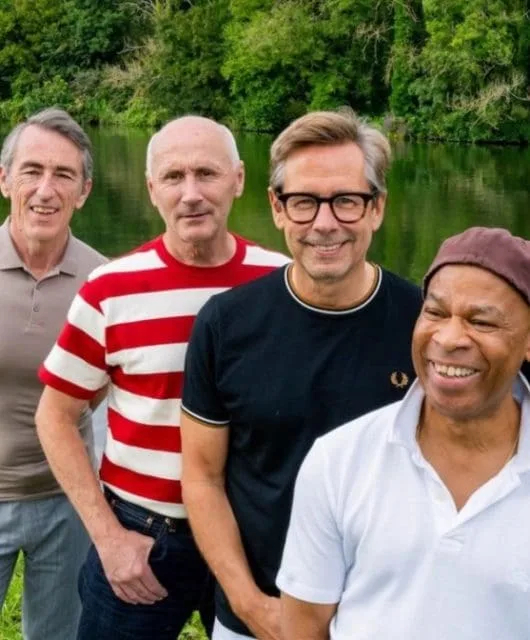Inside The Jam: The Gift
By Steve O'Brien | February 14, 2022
They’d been a fixture on the musical landscape for half a decade, but with the help of one of the singles of the year, the sixth album by The Jam, The Gift, gave them their first No.1 chart-topper. Nevertheless, it was also the record that called time on the woking three-piece…

The Jam made just six LPs over a five-year period, yet those albums chart a musical journey almost as extraordinary as that of Weller’s favourite band The Beatles. By the time of their sayonara album, 1982’s The Gift, Paul Weller, Bruce Foxton and Rick Buckler had shed many of the punk trimmings they’d started out with.
In fact, there was little on that final record that sounded much like the singles that had made their name – the brutal, tightly-wound sound of In The City and The Modern World had morphed, by this time, into something that was much more Northern Soul than simply a three-chord thrash.
It’s difficult to imagine the Jam of 1977 employing wah-wah guitar effects, funk basslines and jazz flourishes, but The Gift reflected the records that Paul Weller had been increasingly drawn to in the years in between. They may have lost a few fans who couldn’t accept the move away from The Jam sound they’d first fallen in love with, but more loyal and less closed-minded listeners understood that they were a band who were ever-evolving.
As DJ and Acid Jazz head Eddie Piller said of The Gift: “Weller was always trying to move them forward creatively, which is a very mod thing to do.”
“For those of you listening in black and white,” says an unnamed voice in some sampled dialogue on first song Happy Together, “this one is in technicolour”. And it’s true. The track, like the rest of the album, is layered with sound and feels as if it’s popping with primary colours, even if melodically it’s the most classic Jam song on here.
Second track Ghosts (which Weller penned in the studio, while improvising with Buckler and Foxton) begins with sliding bass and a low register whisper from Paul and slowly builds, via hand claps and brass, into one of the singer’s most revealing songs (“there’s more inside you that you won’t show,” Weller sings, as if he already knew The Jam would soon be behind him).
Read more: Top pop songs of 1982
Precious had been released in January 1982, two months before the album came out, as a double A-side with A Town Called Malice and it’s a doozy, a propulsive banger with shades of Papa’s Got A Brand New Pigbag (released the year before).
Just Who Is The 5 O’Clock Hero? is as pointedly political as any of The Jam’s greatest work with its bleak sketch of the 9 to 5 slog (“Hello darlin’, I’m home again/ Covered in shit and aches and pains/ Too knackered to think so give me time to come round/ Just gimme the living room beat to the TV sound”), while Trans-Global Express mystifyingly buries Weller’s vocals in a syrupy mix of horns and drums.
Side Two kicks off with the surging Running On The Spot before changing gear for the fine, if throwaway, Bruce Foxton-penned instrumental Circus. The Planner’s Dream Goes Wrong is a calypso-driven number that’s more King Creole And The Coconuts than anything else in The Jam’s back catalogue. While Weller was generally pushing forward on this album, not every experiment worked.
Much better is Carnation, a mournful fan favourite that strangely was never released as a single. Later covered by Liam Gallagher and Steve Cradock, it’s one of the highlights of the album. Just like the Motown-esque next track, A Town Called Malice, a song which, coupled with Precious, would top the chart in the UK in the early months of 1982. Final track The Gift, meanwhile, marked a return to their full-throttle past, with added Stax organ.
The Gift would become the first Jam album to hit the No.1 spot, and it’s still an LP cherished by fans today. If it feels as though there’s something missing, though, it’s that the last two singles recorded by the band aren’t present. The Bitterest Pill (I Ever Had To Swallow) and Beat Surrender were released in the September and November of 1982 and remain two of The Jam’s strongest songs, and would have slotted in nicely.
Looking back on The Gift now, almost 40 years on, with a bit of repackaging you could almost sell the final Jam album as the first Style Council record. When Paul Weller and new collaborator Mick Talbot released Café Bleu in 1984, there wasn’t much sonically between it and The Gift. The record simply sounded like the next stage of Weller’s musical evolution.
It was, however, the final hurrah for Paul Weller, Bruce Foxton and Rick Buckler as a musical unit. But to end your career with a No.1 single and a No.1 album, well, it doesn’t get much better than that.
Read more: Top sophisti-pop albums

Steve O'Brien
Steve O’Brien is a writer who specialises in music, film and TV. He has written for magazines and websites such as SFX, The Guardian, Radio Times, Esquire, The New Statesman, Digital Spy, Empire, Yours Retro, The New Statesman and MusicRadar. He’s written books about Doctor Who and Buffy The Vampire Slayer and has even featured on a BBC4 documentary about Bergerac. Apart from his work on Classic Pop, he also edits CP’s sister magazine, Vintage Rock Presents.www.steveobrienwriter.com





